Related Research Articles
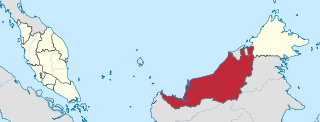
Sarawak is a state of Malaysia. The largest among the 13 states, with an area almost equal to that of Peninsular Malaysia, Sarawak is located in northwest Borneo Island, and is bordered by the Malaysian state of Sabah to the northeast, Kalimantan to the south, and Brunei in the north. The capital city, Kuching, is the largest city in Sarawak, the economic centre of the state, and the seat of the Sarawak state government. Other cities and towns in Sarawak include Miri, Sibu, and Bintulu. As of the 2021, the population of Sarawak was estimated to be around 3.4 million. Sarawak has an equatorial climate with tropical rainforests and abundant animal and plant species. It has several prominent cave systems at Gunung Mulu National Park. Rajang River is the longest river in Malaysia; Bakun Dam, one of the largest dams in Southeast Asia, is located on one of its tributaries, the Balui River. Mount Murud is the highest point in the state. Sarawak is the only state of Malaysia with a Christian majority.
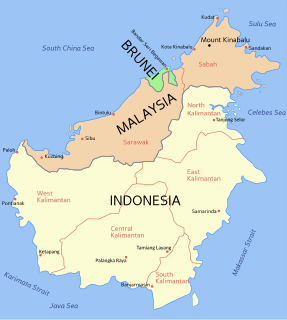
East Malaysia, also known as Sabah, Sarawak and Labuan or Malaysian Borneo, is the part of Malaysia on and near the island of Borneo, the world's third largest island. It consists of the Malaysian states of Sabah and Sarawak, as well as the Federal Territory of Labuan. Labuan is an island in a small archipelago near the coast of Sabah. East Malaysia lies to the east of Peninsular Malaysia, the part of the country on the Malay Peninsula. The two are separated by the South China Sea.
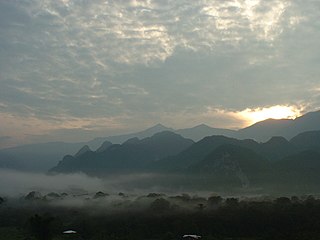
The Gunung Mulu National Park is a national park in Miri Division, Sarawak, Malaysia. It is a UNESCO World Heritage Site that encompasses caves and karst formations in a mountainous equatorial rainforest setting. The park is famous for its caves and the expeditions that have been mounted to explore them and their surrounding rainforest, most notably the Royal Geographical Society Expedition of 1977–1978, which saw over 100 scientists in the field for 15 months. This initiated a series of over 20 expeditions now named the Mulu Caves Project.
Sarawak Chamber is the largest known cave chamber in the world by area and the second largest by volume after the Miao Room in China. It is in Gua Nasib Bagus, which is located in Gunung Mulu National Park, in the Malaysian Territory of Sarawak on the island of Borneo.
Gunung Buda National Park is a national park located in Limbang Division, Sarawak, Malaysia. It is located to the north of Gunung Mulu National Park. Gunung Buda National Park was gazetted in 2001. As in September 2017, the national park was in the planning stage for tourism activities. Roads were also planned to connect Gunung Buda with Gunung Mulu National Park. Gunung Buda meaning White Hill in Lun Bawang language.
Mount Benarat is a mountain located in Gunung Mulu National Park in Sarawak, Malaysia. Consisting of limestone on the western side which is overlain by gritstone on the eastern side. It contains many caves which have been discovered and explored by British and American cavers. The Benarat 2005 Caving Expedition discovered Moon Cave after climbing 60 m up the cliffs on the southern end of the mountain. On the eastern side, the Headhunter's Trail leads from the Melinau River to the mouth of the Terikan River at the Medalam River. Neighbouring Mount Buda and Mount Api are part of the same formation, separated from Mount Benarat by the Medalam and Melinau Rivers, respectively. It is also home to Benarat Cavern.
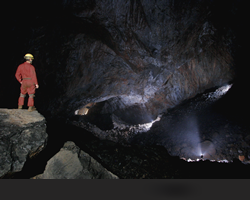
Api Chamber is a chamber in Whiterock Cave in Mount Api, Gunung Mulu National Park, Sarawak, Malaysia. Measuring 300 m by 200 m and with a surveyed circumference of 900 m it is the ninth largest cave chamber by area in the world. Its height is over 100 m and its plan area is 58,000 square metres. It is the second largest chamber in Malaysia, after Sarawak Chamber.

Malaysia was once ranked 9th in the world for tourist arrivals. The Travel and Tourism Competitiveness Report 2017 ranks Malaysia 25th out of 141 countries overall.

Mulu Airport is an airport in the state of Sarawak in Malaysia and a gateway to the Gunung Mulu National Park. There are resort accommodations at the National Park, but the nearest villages are Long Terawan, downstream 21.7 km (13.5 mi) to the west, and Long Atip 26.1 km (16.2 mi) to the south. Rumah Bawang Grang in Brunei is only 23.1 km (14.4 mi) to the north-northwest, but there is no road connected to the airport.

Mount Mulu is a sandstone and shale mountain. At 2376 m, it is the second highest mountain in the state of Sarawak, after Mount Murud. It is located within the boundaries of Gunung Mulu National Park, which is named after it.
Ansonia torrentis is a species of toad in the family Bufonidae. It is endemic to Mount Mulu in Sarawak, Borneo, Malaysia. It is known from beside a small, clear, mountain stream with a steep gradient. Its known distribution is within the Gunung Mulu National Park.
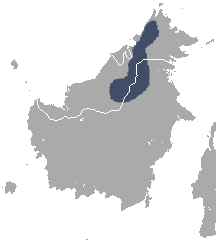
The Bornean smooth-tailed treeshrew is a species of treeshrew in the family Tupaiidae. It is endemic to Borneo. Its natural habitat is subtropical or tropical dry forests. It is threatened by habitat loss.

The Malayan tailless leaf-nosed bat is a species of bat in the family Hipposideridae. It is a very small bat which has long and soft fur. The fur coloration is brown to blackish on the dorsal surface and ashy on the ventral surface. It can be distinguished from the other roundleaf bats by its small size and the absence of the tail. It is listed as vulnerable by the IUCN
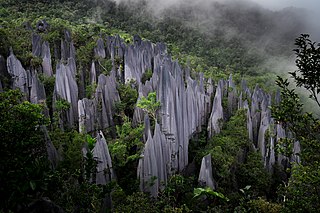
Mount Api is a limestone mountain located in Gunung Mulu National Park in Sarawak, Malaysia. Neighbouring Mount Benarat and Mount Buda are part of the same formation. Mount Api is famous for its striking limestone karst formations, commonly called "the pinnacles".

Deer Cave, located near Miri, Sarawak, Malaysia, is a show cave attraction of Gunung Mulu National Park. It was surveyed in 1961 by G. E. Wilford of the Malaysian Geological Survey, who predicted that Mulu would yield many more caves in the future. The cave, which is also known as Gua Payau or Gua Rusa by the local Penan and Berawan people, is said to have received its name because of the deer that go there to lick salt-bearing rocks and shelter themselves.

The Clearwater Cave System in Gunung Mulu National Park, Sarawak, Malaysia is believed to be one of the largest interconnected cave systems in the world by volume and the 9th longest cave in the world at 236.796 km (147.138 mi) (2020). The system lies mainly under the western margins of Gunung Api between the Melinau Gorge and Cave of the Winds.
Lithocarpus muluensis is a tree in the beech family Fagaceae. It is named for Gunung Mulu mountain in Sarawak, Borneo.
References
- 1 2 3 4 5 6 "Good Luck Cave (Nasib Bagus)". Mulu Caves Project. Archived from the original on 20 November 2017. Retrieved 29 October 2018.
- 1 2 "Sarawak chamber overnight at Camp 1". Mulu National Park. Archived from the original on 11 February 2018. Retrieved 29 October 2018.
- ↑ "Gunung Mulu National Park" . Retrieved 29 March 2017.
- ↑ "Eco Over Easy: A Guide to Malaysia's Eco Resorts". Wild Asia. Archived from the original on 2007-08-30. Retrieved 2008-02-21.